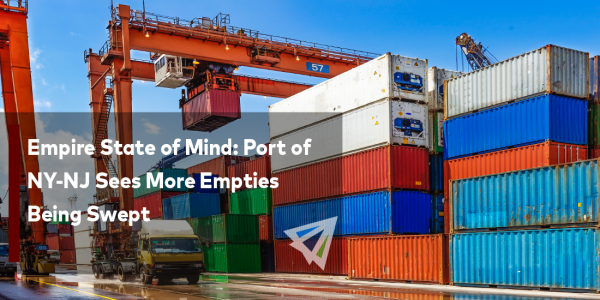Competitive Edge
November 30th, 2022
UPDATE: U.S. and Canada Ports – Number of Cargo Vessels at Anchor
• Vancouver: 29 Vessels at Anchor (-1)
• Savannah: 26 Vessels at Anchor (-1)
• Houston: 20 Vessels at Anchor (+12)
• San Francisco/Oakland: 5 Vessels at Anchor (-2)
• Los Angeles/Long Beach: 6 Vessels at Anchor (+2)
• Mobile: 8 Vessels at Anchor (+2)
• New York/Newark: 3 Vessels at Anchor (+1)
• Charleston: 1 Vessels at Anchor (-1)
Note: Count taken on November 29, 2022. This count does not include vessels moored and being unloaded at port docks. Colored numbers in parentheses represents the change from last week over. Data is courtesy of MarineTraffic’s live vessel traffic map.
Have another U.S. or Canadian port you’d like us to track weekly? Let us know!
Takeaways
• U.S. West Coast: It was recently announced that the SoCal sister ports Los Angeles and Long Beach have “zero” vessels waiting off its coast.
While Marine Traffic reports six vessels (as of November 29) at anchor, insiders say these ships are in queue “by choice”. For a closer look at this development, please click here.
• U.S. Gulf Coast: Gulf Coast ports got a boost in import and export volumes in October.
Port Houston has POSTPONED its sustained dwell fee, due to delays from the port’s external software developer. The fee was originally scheduled for Dec. 1st. The port will give customers a 30-day notice before the fee gets implemented again.
Houston, which saw 12 vessels added week-over-week to its count, observed a 13 percent increase in container volume. The port’s chairman says there hasn’t been any signs of “softening” demand at Houston.
Please refer to our articles section below for more details.
• U.S. East Coast: Savannah keeps its spot as the black sheep of the EC. The Georgian port continues treading in the high twenties. On the other hand, its EC peers, like New York and Charleston, are enjoying minimal backlogs.
• Canada: Vancouver has slipped under 30 vessels for its first time in several weeks. However, berthing delays continue to plague Canada’s premier gateway.
IMPORT: Asia to North America (TPEB)
Recent Developments:
• West Coast contract negotiations between the International Longshore and Warehouse Union (ILWU) and Pacific Maritime Association (PMA) remain active. The existing labor contract between the two parties expired July 1.
• Rail congestion is considerable at most ports, including inland hubs.
- Los Angeles, Long Beach, and Houston remain at the forefront for dwell times – hovering around 12-15 days. However, these times have improved the last few weeks.
Rates: Near pre-pandemic rate levels continue steadily falling. Speculation remains on when or if we will hit a post-pandemic floor with ocean freight and what rates will settle as.
Space: Space is open.
Capacity: Capacity remains generally open for transpacific trade. Carriers are struggling to match capacities with plummeting demand.
Equipment: Chassis availability is in a crunch in pockets, but with production amping up and lower import volumes coming through, there is hope of relief. Congested rail ramps remain an issue.
TIPS:
• Book at least two weeks prior to the ready date.
• For cargo ready now, take advantage of open space and softened rates on the spot market.
• Blank sailings are in play which may affect schedule integrity.
IMPORT: Europe to North America (TAWB)
Recent Developments:
• Labor-related tensions continue at Britain’s largest port, Felixstowe, as its dockworkers and port employers remain without a new labor deal.
Please watch our recent webinar for a closer look at the U.K.’s current labor tensions. We were joined by our British partners and discussed the impacts in greater detail.
Rates: Rates are expected to fall in December due to less demand. Many carriers have cut back on their Peak Season Surcharge (PSS) fees.
Space: Space to both U.S. coasts have opened up from introductions of more vessels in October and November.
Capacity: Capacity has improved, but not to the extent that was expected through November.
Equipment: Equipment availability at European seaports is still in a crunch. Inland terminals in Europe are also still reporting equipment shortages.
TIPS:
• Book at least four weeks prior to ready date.
• Stay up to date with your forwarder and carrier with advisories on added capacities and declining rates for the trade lane.
• Strongly consider premium services for no-roll options and improved reliability of cargo.
EXPORT: North America to Asia
Recent Developments:
• Savannah’s congestion remains a lead contributor to operational woes at the Georgian port.
Rates: So far, no GRIs announced for December.
Capacity: Capacity remains stable.
Equipment: Inland ports, notably Kansas City and Memphis, are reporting container and chassis deficits (the latter improving). Standard equipment at ports remains available unless advised otherwise.
TIPS:
• Book at least four weeks prior to the time of departure to secure necessary equipment.
InterlogUSA Proudly Presents...

Offering insights into breaking news, market trends, our company’s history, and more.
“FreightFM” features short-form video interviews with InterlogUSA’s industry experts.
Did You Know: Florida Sees Setbacks on Citrus Groves after Hurricane Ian, as the U.S. Piles up Orange Juice from Brazil
Florida has seen a plunge in orange juice production – there lowest in 79 years – after Hurricane Ian and citrus greening disease took over.
Shipments from Brazil to the U.S. have increased nearly 60% in the first four months of the season, compared to a year ago.
Source: AJOT
Freight News
The FAA is Distributing Funds for Airports Throughout the U.S. to Help Deal with Winter Weather
It’s almost that time of year …winter! As some parts of the country already know, winter weather has or will be starting again soon, and with that, has the potential to cause some disruptions in the transportation/supply chain industry.
Recently, the U.S. Department of Transportation’s Federal Aviation Administration (FAA) awarded over $76 million in Fiscal Year 2022 to 85 airports in 28 states, the American Journal of Transportation reports. This funding, from the FAA’s Airport Improvement Program, is for snowplows, de-icing equipment, and new or upgraded buildings to store this equipment in this winter.
Of that $76 million, $46.2 million will be used to purchase snow removal equipment specifically for airports in Ohio, Alaska, Michigan, and Washington.
While $13,6 million will be used to develop de-icing facilities specifically for airports in New Jersey, Montana, and North Dakota.
Finally, $16.4 million will be used to construct and renovate builds that store and maintain snow removal equipment, specifically for airports in West Virginia, Washington, Minnesota, and California.
It’s hard to be 100 percent prepared for the unexpected but being informed on different options and ways to navigate those events, can be helpful. Recently, we put out episode 2 of our podcast, FreightFM, which detailed options and tips on how to be prepared and proactive when dealing with emergency or unexpected events.
You can check it out here, if you are interested!
Ports in the U.S. Gulf Coast Continue to See an Increase in Volumes Through October
Port Houston: Throughout the month of October, a total of 371,994 twenty-foot equivalent units (TEUS) were handled at the port. If you compare that to October 2021, that is a 13% increase, which is quite significant.
Additionally, Port Houston has seen container volume up 18% through year-to-date at the port terminals, per the port’s news release.
Furthermore, the port plans to start implementing an import dwell fee early next year, in an effort to improve long-term container dwell at the port.
Port of New Orleans: Throughout the month of October, the port saw significant increases of breakbulk and container cargo volumes. Just in October this year, the port saw a total of 150,313 short tons of breakbulk tonnage.
In addition to that, the port also totaled 41,934 TEUS of container cargo for the month of October. As Freight waves reports, that is up 8% year to date.
Port of Corpus Christi: Throughout October, the port moved nearly 17 million tons of cargo, which is up 15% year-over-year from 2021.
Additionally, shipments of crude oil topped at 10.3 million tons through October, which posted a 24% year-over-year increase, data from Freight Waves shows.
Port of Mobile: October this year was the port’s second highest monthly container volume total month in the port’s history. Data shows, the port handled 45,990 TEUS for October, which is up 5% compared to this time last year.
Missed This Month's Webinar? Watch Here Now!
Sign Up for Next Month's Webinar
Our next webinar will be on Wednesday, December 21st – Time: TBD
Additionally, stay tuned for the announcement of
who our next special guests will be!
Finally, we would like to hear from you!
If you have any questions or topics you would like our experts
to discuss in future webinars, please let us know!
You can email us at [email protected]
Interlog  Insights
Insights
We hope everyone had a great Thanksgiving last week. This week we will be premiering our December ‘Magic Freight Ball’ prediction – so make sure you’re signed up to receive that for this Friday’s Interlog Insights Newsletter!
Sign up for our
industry answers
Our team works to provide valuable, unique, and relevant content to assist you in finding solutions. Sign up now.

